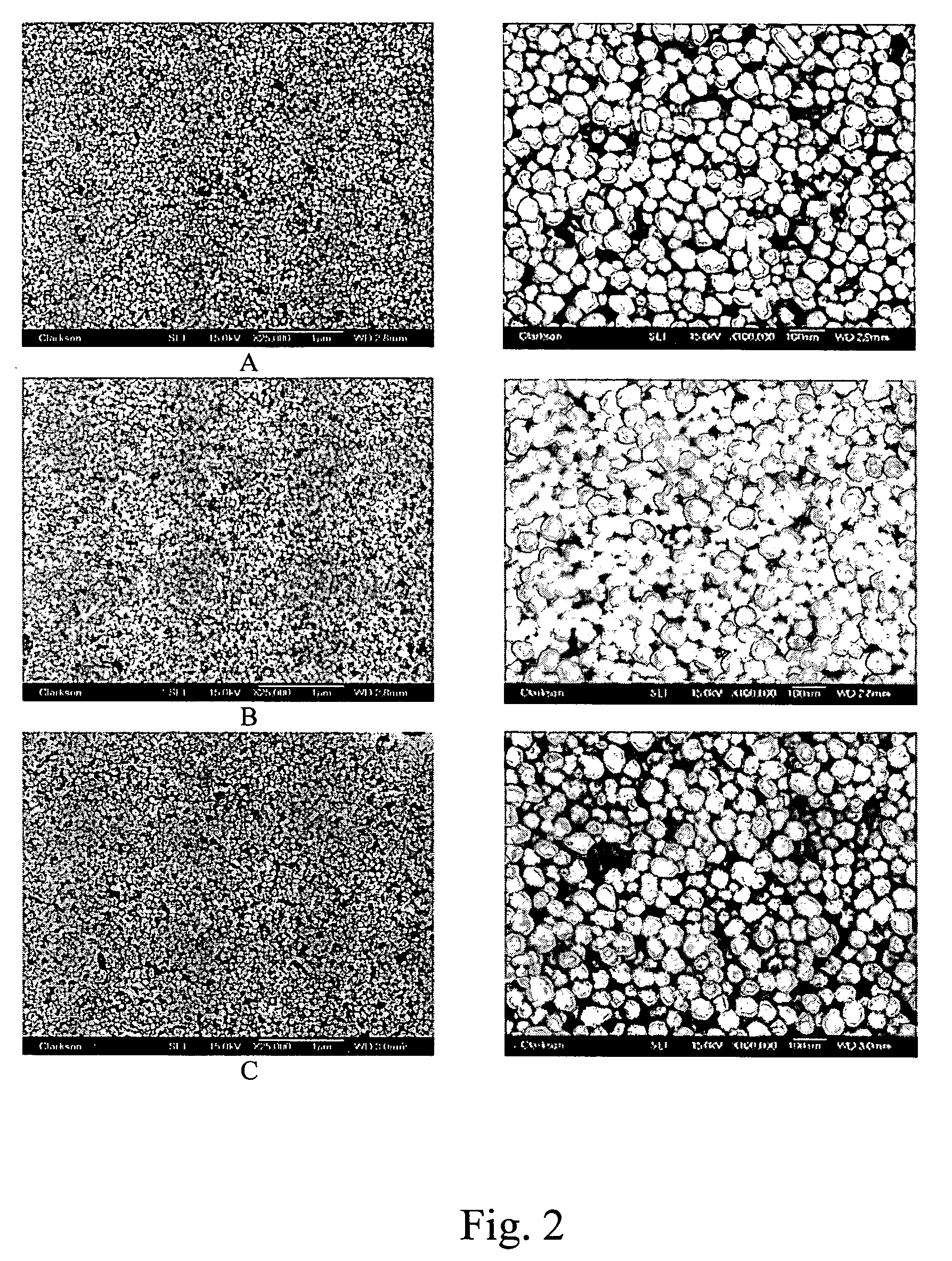Aqueous-based method for producing ultra-fine metal powders
a technology of metal powder and aqueous solution, which is applied in the field of ultra-fine metal powder, can solve the problems of complex equipment required in the process and the general higher cost of metallic powder produced
- Summary
- Abstract
- Description
- Claims
- Application Information
AI Technical Summary
Benefits of technology
Problems solved by technology
Method used
Image
Examples
example 1
Materials
[0034] Silver nitrate (AgNO3) was obtained from Ames Goldsmith Corp. (Glens Falls, N.Y.). Gum arabic was obtained from Frutarom Incorporated (North Bergen, N.J.). Ammonium hydroxide (NH4OH) was purchased from Fischer Scientific Co. (Fair Lawn, N.J.). Acetone, ethanol, and sodium hydroxide (NaOH) solution (10 N) were supplied by Alfa Aesar (Ward Hill, Mass.). D-glucose was purchased from Avocado Research Chemicals Ltd. (Shore Road, Heyshane, Lancs.). Cupric nitrate hydrate [Cu(NO3)2 2 1 / 2H2O] was obtained from T.J. Baker Chemical Co. (Phillipsburg, N.J.), while the palladium nitrate solution 9.0% was obtained from Umicore (South Plainfield, N.J.).
example 2
Preparation of Ultra-Fine Silver Particles
(A) Preparation of the Reducing Solution
[0035] 3 L deionised (“DI”) water was heated to 55° C. in a 8 L stainless steel beaker. When the temperature reaches 55° C., 62.5 g gum arabic was slowly added into the water and dissolved by stirring the solution with a stirring propeller at low speed for 55 minutes. 36 g of D-glucose were then added to the solution. The mixture was stirred at 1700 rpm for 5 minutes.
(B) Preparation of Silver Ammonium Complex Solution
[0036] 198.7 g AgNO3 were dissolved in 234 ml DI water in a 2 L glass beaker. After the silver nitrate was completely dissolved, 195 ml ammonium hydroxide was added under stirring, followed by the addition of 291 ml DI water to reach a final volume of 720 ml.
(C) Preparation of Ultra-Fine Silver Particles
[0037] The reduction process was conducted by pumping the silver ammonium solution into the reducing solution at a flow rate of 8 ml / min using a peristaltic pump. When the addition of...
example 3
Preparation of Ultra-Fine Palladium Particles
(A) Preparation of the Reducing Solution
[0040] A volume of 500 ml DI water was heated to 70° C. in 2 L glass beaker. When the temperature reaches 70° C., 10 g gum arabic was slowly added into the water and dissolved by stirring the solution. 100 g of D-glucose were then added to the solution and the mixture was stirred at 1700 rpm for 5 minutes. The pH of solution was adjusted at 10.5 with 10.0 N NaOH.
(B) Preparation of Palladium Ammonium Complex Solution
[0041] 80 ml ammonium hydroxide was added quickly under stirring to 50 ml Pd(NO3)2 solution 9.0% in a 0.2 L glass beaker, followed by the addition of 50 ml DI water (final volume: 180 ml).
(C) Preparation of Ultra-Fine Palladium Particles
[0042] The reducing reaction was conducted by pumping the palladium ammonium solution to the reducing solution at a flow rate of 5 ml / min using a peristaltic pump. When the addition of the palladium complex solution is completed, the temperature was ...
PUM
| Property | Measurement | Unit |
|---|---|---|
| size | aaaaa | aaaaa |
| flow rate | aaaaa | aaaaa |
| flow rate | aaaaa | aaaaa |
Abstract
Description
Claims
Application Information
 Login to View More
Login to View More - R&D
- Intellectual Property
- Life Sciences
- Materials
- Tech Scout
- Unparalleled Data Quality
- Higher Quality Content
- 60% Fewer Hallucinations
Browse by: Latest US Patents, China's latest patents, Technical Efficacy Thesaurus, Application Domain, Technology Topic, Popular Technical Reports.
© 2025 PatSnap. All rights reserved.Legal|Privacy policy|Modern Slavery Act Transparency Statement|Sitemap|About US| Contact US: help@patsnap.com



